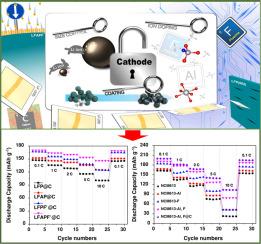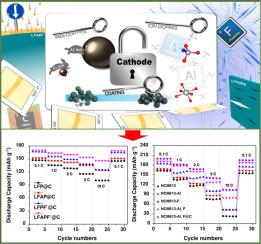基于Al-F-C协同的高级阴极动态CEI结构界面重编程
IF 20.2
1区 材料科学
Q1 CHEMISTRY, PHYSICAL
引用次数: 0
摘要
对于商用锂离子电池来说,在高倍率运行下实现强大的界面稳定性仍然是一个巨大的挑战,特别是在极端循环条件下的阴极。在这里,我们提出了一种精心策划的界面重编程策略,该策略集成了Al³/F⁻-掺杂和适形碳涂层,以指导自对准、富liff的阴极电解质界面(CEI)的形成。与传统的基于单元素掺杂或惰性表面涂层的CEI调节策略不同,这种多组分方法通过掺杂剂和碳的协同相互作用,实现了主动构建、晶体排列的CEI。这种方法可以实现动态CEI结构,从而最大限度地减少界面阻力并增强锂离子传输动力学。作为概念验证,LiFePO₄(LFP)被用作模型系统,在10C时提供146.6 mAh g⁻¹的超快放电容量,在1C时提供2931次循环的超长寿命和100%的库仑效率。XPS和原位XRD分析证实了富liff CEI的优先取向,这与电化学性能的提高有关。为了验证该方法的平台独立性,将相同的界面框架扩展到分层NCM613阴极上,尽管没有可检测到的晶体liff信号,但该阴极表现出显著的性能增强,这可能是由于形成了更薄、更均匀的CEI层。这项工作建立了一个通用的、主动可调的CEI工程范例,超越了传统的被动方法,为大功率、长寿命锂离子电池的发展提供了一条变革性的途径。本文章由计算机程序翻译,如有差异,请以英文原文为准。


Orchestrated interfacial reprogramming via Al–F–C synergy for dynamic CEI structuring in advanced cathodes
Achieving robust interfacial stability under high-rate operation remains a grand challenge for commercial lithium-ion batteries, particularly in cathodes subjected to extreme cycling conditions. Herein, we propose an orchestrated interfacial reprogramming strategy that integrates Al³⁺/F⁻ co-doping and conformal carbon coating to direct the formation of a self-aligned, LiF-rich cathode–electrolyte interphase (CEI). Unlike conventional CEI regulation strategies based on single-element doping or inert surface coatings, this multi-component approach enables an actively constructed, crystallographically aligned CEI through the synergistic interplay of dopants and carbon. This approach enables dynamic CEI structuring that minimizes interfacial resistance and enhances lithium-ion transport kinetics. As a proof of concept, LiFePO₄ (LFP) was employed as a model system, delivering an ultrafast discharge capacity of 146.6 mAh g−1 at 10C and exceptional longevity with 2931 cycles at 1C and 100 % Coulombic efficiency. XPS and in situ XRD analyses confirmed the preferential orientation of the LiF-rich CEI, linked to the improved electrochemical performance.
To validate the platform independence of this approach, the same interfacial framework was extended to layered NCM613 cathodes, which exhibited significant performance enhancement despite the absence of detectable crystalline LiF signals—likely due to the formation of a thinner, more uniform CEI layer. This work establishes a universal and actively tunable CEI engineering paradigm that transcends traditional passive approaches, offering a transformative pathway toward high-power, long-life lithium-ion batteries.
求助全文
通过发布文献求助,成功后即可免费获取论文全文。
去求助
来源期刊

Energy Storage Materials
Materials Science-General Materials Science
CiteScore
33.00
自引率
5.90%
发文量
652
审稿时长
27 days
期刊介绍:
Energy Storage Materials is a global interdisciplinary journal dedicated to sharing scientific and technological advancements in materials and devices for advanced energy storage and related energy conversion, such as in metal-O2 batteries. The journal features comprehensive research articles, including full papers and short communications, as well as authoritative feature articles and reviews by leading experts in the field.
Energy Storage Materials covers a wide range of topics, including the synthesis, fabrication, structure, properties, performance, and technological applications of energy storage materials. Additionally, the journal explores strategies, policies, and developments in the field of energy storage materials and devices for sustainable energy.
Published papers are selected based on their scientific and technological significance, their ability to provide valuable new knowledge, and their relevance to the international research community.
 求助内容:
求助内容: 应助结果提醒方式:
应助结果提醒方式:


